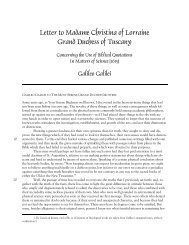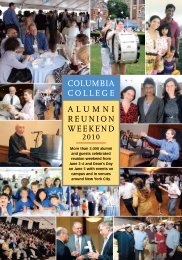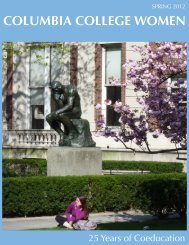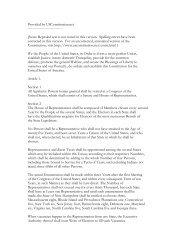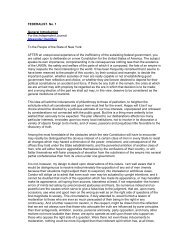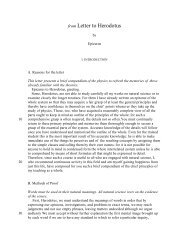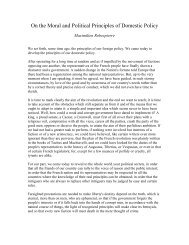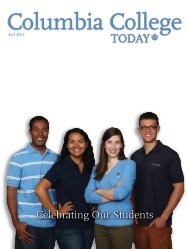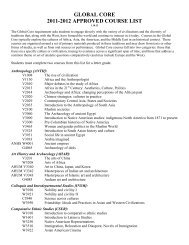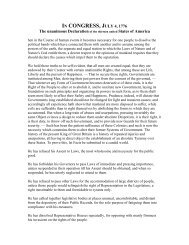Download this issue as a PDF - Columbia College - Columbia ...
Download this issue as a PDF - Columbia College - Columbia ...
Download this issue as a PDF - Columbia College - Columbia ...
Create successful ePaper yourself
Turn your PDF publications into a flip-book with our unique Google optimized e-Paper software.
BOOKSHELF<br />
COLUMBIA COLLEGE TODAY<br />
COLUMBIA COLLEGE TODAY<br />
Biomedical Consulting Agreements:<br />
A Guide for Academics by<br />
H. Robert Horvitz and Edward Klees<br />
’81. A guide for academic scientists<br />
and physicians who are considering<br />
consulting work in the field of<br />
biomedicine (The MIT Press, $30).<br />
Change the World Before Bedtime,<br />
by Mark Kimball Moulton, Josh<br />
Chalmers ’86 and Karen Good. With<br />
rhyme, Chalmers teaches children<br />
that, through simple deeds, kind<br />
words and smiles, they can change<br />
the world a little at a time (Schiffer<br />
Publishing, $16.99).<br />
The Pope Stories and Other Tales<br />
of Troubled Times by George Guida<br />
’89. Guida addresses Catholicism,<br />
family conflict and personal strife<br />
in <strong>this</strong> collection of satirical and<br />
philosophical fiction (Bordighera<br />
Press, $15).<br />
How to Look Hot in a Minivan:<br />
A Real Woman’s Guide to Losing<br />
Weight, Looking Great, and<br />
Dressing Chic In the Age of the<br />
Celebrity Mom by Janice Min ’90.<br />
Min pulls together f<strong>as</strong>hion, nutrition,<br />
fitness and beauty tips from<br />
Hollywood’s top experts for new<br />
or expecting mothers (St. Martin’s<br />
Press, $26.99).<br />
Plaguewalker by Gemma Tarlach<br />
’90. In Tarlach’s dark fiction debut,<br />
Marcus of Ansberg, an executioner<br />
in plague-ravaged 14th-century<br />
Bavaria, embarks on a journey of<br />
atonement and redemption while<br />
searching for his missing daughter<br />
(Grun<strong>as</strong>khan Books, $8.99).<br />
Mobile Marketing: An Hour a Day<br />
by Rachel P<strong>as</strong>qua and Noah Elkin ’91.<br />
Learn how to develop and deploy<br />
mobile marketing strategies for<br />
everything from brand building to<br />
lead generation and sales to establishing<br />
a compelling mobile presence<br />
(Wiley, John & Sons, $29.99).<br />
Glorieta by Quinn Kayser-Cochran<br />
’92. Two young lovers find each<br />
other during the decisive battle in<br />
the New Mexico Campaign of the<br />
Civil War (Westland Books, $19.95).<br />
Your Next Big Thing: 10 Small<br />
Steps to Get Moving and Get Happy<br />
by Ben Michaelis ’95. Practical<br />
strategies, quizzes and exercises to<br />
help those who are feeling “stuck”<br />
to realize their purpose, achieve<br />
their goals and learn about their<br />
true selves (Adams Media, $24.95).<br />
A Secret History of Coffee, Coca<br />
& Cola written and illustrated by<br />
Ricardo Cortés ’95. In <strong>this</strong> work of<br />
artistic journalism, Cortés explores<br />
the history of the coca leaf and its<br />
controversial relationship with the<br />
Coca-Cola Co. (Ak<strong>as</strong>hic Books,<br />
$17.95).<br />
Jewish Jocks: An Unorthodox<br />
Hall of Fame edited by Franklin<br />
Foer ’96 and Marc Tracy. This collection<br />
of biographical, sociological<br />
and reflective pieces by numerous<br />
authors, including Foer, explores<br />
the influences of significant Jewish<br />
athletes, coaches, broadc<strong>as</strong>ters,<br />
trainers and team owners (Twelve,<br />
$26.99).<br />
Becoming Frum: How Newcomers<br />
Learn the Language and Culture of<br />
Orthodox Judaism by Sarah Bunin<br />
Benor ’97. The author explains how<br />
non-Orthodox Jews learn Orthodox<br />
language and culture through interactions<br />
with community veterans<br />
and other newcomers (Rutgers<br />
University Press, $27.95).<br />
The Politics of Energy and Memory<br />
between the Baltic States and<br />
Russia by Agnia Grig<strong>as</strong> ’02. Grig<strong>as</strong><br />
dissects the relationship between<br />
Russia and the Baltic States in<br />
terms of energy security concerns,<br />
foreign policy and historical legacy<br />
(Ashgate, $99.95).<br />
Tokyo Utopia by Yuma Terada ’05.<br />
Observing Japanese society from<br />
within and abroad, Terada addresses<br />
foreign perceptions of<br />
Japan and Japanese culture and<br />
also how Japan should respond to<br />
these misperceptions (Bungheisha,<br />
JPY 1,200).<br />
Taking It Big: C. Wright Mills<br />
and the Making of Political Intellectuals<br />
by Stanley Aronowitz. The<br />
author describes the role of the<br />
late Mills, a professor of sociology<br />
at <strong>Columbia</strong> from 1946–62,<br />
in transforming the politics of the<br />
American Left in the 1940s and<br />
’50s and his influence on student<br />
protests and antiwar movements<br />
of the ’60s (<strong>Columbia</strong> University<br />
Press, $32.50).<br />
Globalization and Sovereignty:<br />
Rethinking Legality, Legitimacy,<br />
and Constitutionalism by Jean L.<br />
Cohen, the Nell and Herbert Singer<br />
Professor of Contemporary Civilization<br />
and Political Theory. Cohen<br />
analyzes the new sovereignty regime<br />
emergent since 1990 and argues<br />
for the continued importance<br />
of sovereign equality (Cambridge<br />
University Press, $36.99).<br />
Theos Bernard, the White Lama:<br />
Tibet, Yoga, and American<br />
Religious Life by Paul G. Hackett,<br />
lecturer in the discipline of cl<strong>as</strong>sical<br />
Tibetan in the Department<br />
of Religion. Through interviews,<br />
diary entries and personal documents,<br />
Hackett examines the<br />
religious, political and cultural<br />
impact of Bernard, only the third<br />
American to enter the holy capital<br />
city of Lh<strong>as</strong>a, Tibet (<strong>Columbia</strong><br />
University Press, $32.95).<br />
The Generation of Postmemory:<br />
Writing and Visual Culture<br />
After the Holocaust by Marianne<br />
Hirsch, the William Peterfield Trent<br />
Professor of English and Comparative<br />
Literature. Hirsch posits that<br />
the memory of others’ traumatic<br />
events can shape the behavior of<br />
their family members and the culture<br />
at large (<strong>Columbia</strong> University<br />
Press, $27.50).<br />
Lead Wars by Gerald Markowitz,<br />
adjunct professor of sociomedical<br />
sciences at the Mailman School of<br />
Public Health, and David Rosner,<br />
the Ronald H. Lauterstein Professor<br />
of Sociomedical Sciences and<br />
professor of history. An incisive<br />
examination of lead poisoning<br />
during the p<strong>as</strong>t half century and a<br />
call to action for more responsible<br />
public health and prevention in the<br />
face of powerful polluters (University<br />
of California Press, $34.95).<br />
Ike’s Bluff: President Eisenhower’s<br />
Secret Battle To Save the<br />
World by Evan Thom<strong>as</strong>. Working<br />
with newly decl<strong>as</strong>sified papers,<br />
Thom<strong>as</strong> reveals how President<br />
Eisenhower, also the 13th president<br />
of <strong>Columbia</strong>, made a highrisk<br />
but ultimately successful<br />
bluff with nuclear weapons during<br />
the Cold War (Little, Brown<br />
and Co., $29.99).<br />
Karl Daum ’15<br />
Obituaries<br />
1930<br />
Malcolm S. M<strong>as</strong>on, attorney, Earlysville,<br />
Va., on November 1, 2011.<br />
M<strong>as</strong>on w<strong>as</strong> born in the Bronx in<br />
June 1910. He w<strong>as</strong> a 1934 graduate<br />
of the Law School and had lived<br />
in the Earlysville area since 2003.<br />
M<strong>as</strong>on w<strong>as</strong> an expert in federal<br />
grants law and w<strong>as</strong> legal counsel in<br />
several federal agencies, including<br />
the National Labor Relations Board,<br />
the Office of Economic Opportunity<br />
and the Department of Health,<br />
Education, and Welfare. Up to the<br />
time of his death, he w<strong>as</strong> serving <strong>as</strong><br />
a senior fellow to the Administrative<br />
Conference of the United States.<br />
M<strong>as</strong>on w<strong>as</strong> predece<strong>as</strong>ed by his<br />
wife, Irma; brother; and sister. He is<br />
survived by his daughter, Jan, and<br />
her husband, Ed Freundschuh; son,<br />
Mike; and two granddaughters.<br />
1931<br />
Paul E. Queneau, Hanover, N.H.,<br />
on March 31, 2012. Queneau w<strong>as</strong><br />
born on March 20, 1911, in Philadelphia.<br />
He earned a B.A. <strong>as</strong> well<br />
<strong>as</strong> a B.S. (1932) and Ph.D. (1933),<br />
the latter two at Engineering, and<br />
began work at International Nickel<br />
Co.’s (INCO) Huntington, W.Va., alloy<br />
plant. Queneau graduated from<br />
the Army Engineer School and w<strong>as</strong><br />
deployed to Europe with the U.S.<br />
Army Corps of Engineers. He w<strong>as</strong><br />
awarded the Bronze Star Medal, the<br />
Army Commendation Medal and<br />
Obituary Submission<br />
Guidelines<br />
<strong>Columbia</strong> <strong>College</strong> Today<br />
welcomes obituaries for<br />
<strong>College</strong> alumni. Deaths are<br />
noted in the next available<br />
<strong>issue</strong> in the “Other Deaths<br />
Reported” box. Complete<br />
obituaries will be published in<br />
an upcoming <strong>issue</strong>, pending<br />
receipt of information. Due<br />
to the volume of obituaries<br />
that CCT receives, it may<br />
take several <strong>issue</strong>s for the<br />
complete obituary to appear.<br />
Word limit is 200; text may be<br />
edited for length, clarity and<br />
style at the editors’ discretion.<br />
Click “Contact Us” at college.<br />
columbia.edu/cct, or mail<br />
materials to Obituaries Editor,<br />
<strong>Columbia</strong> <strong>College</strong> Today,<br />
<strong>Columbia</strong> Alumni Center,<br />
622 W. 113th St., MC 4530,<br />
6th Fl., New York, NY 10025.<br />
Paul E. Queneau ’31<br />
earned five battle stars on his ETO<br />
ribbon. In 1945 he returned to the<br />
Reserve <strong>as</strong> a lieutenant colonel. In<br />
1949, Queneau explored, mapped<br />
and photographed the Perry River<br />
region of the Arctic. He retired<br />
from INCO after 35 years and in<br />
1971 joined the Thayer School of<br />
Engineering at Dartmouth, teaching<br />
there for 25 years. Queneau and<br />
his wife, Joan (née Hodges), spent<br />
their free time on their farm near<br />
Cornish, N.H. She predece<strong>as</strong>ed<br />
him. Queneau is survived by his<br />
children, Paul and his wife, Jean,<br />
and Josie; six grandchildren; seven<br />
great-grandchildren; and brother,<br />
Bernard ’30, ’33E, and his wife,<br />
Esther. Memorial contributions may<br />
be made to the Queneau Scholarship<br />
Fund, Town of Cornish, 488<br />
Town House Rd., Cornish, NH<br />
03745, or the Fry Fund, Kendal at<br />
Hanover, 80 Lyme Rd., Hanover,<br />
NH 03755.<br />
1932<br />
Leonard S. B<strong>as</strong>es, otolaryngologist<br />
and surgeon, Sar<strong>as</strong>ota, Fla., on January<br />
25, 2012. At the <strong>College</strong>, B<strong>as</strong>es<br />
w<strong>as</strong> elected to Phi Beta Kappa. At<br />
the depth of the Great Depression<br />
he and his brother, Joe, won his first<br />
year’s P&S tuition by betting on a<br />
long shot at the races. He earned<br />
the rest of his tuition by working<br />
<strong>as</strong> a shoe salesman and selling his<br />
blood. B<strong>as</strong>es graduated from P&S in<br />
1936 and w<strong>as</strong> elected to the Alpha<br />
Omega Alpha Medical Honor<br />
Society. He w<strong>as</strong> an intern, resident<br />
and house surgeon at Mount Sinai<br />
Hospital, a diplomate of the American<br />
Board of Otolaryngology and<br />
a fellow of the American <strong>College</strong> of<br />
Surgeons. During WWII, he served<br />
in the Army Medical Corps. After<br />
the war B<strong>as</strong>es w<strong>as</strong> a Special Fellow<br />
in head and neck surgery at the<br />
Memorial Sloan-Kettering Cancer<br />
Center in New York City. He served<br />
chiefly during the next 30 years <strong>as</strong><br />
an attending otolaryngologist at the<br />
Northern Westchester Hospital in<br />
Mount Kisco, N.Y. He also devoted<br />
10 years to teaching and practicing<br />
medicine in Afghanistan and Java<br />
<strong>as</strong> a volunteer with CARE/Medico.<br />
Survivors include his wife of 71<br />
years, Ann; sons, John and Terry;<br />
daughter-in-law, Deborah; two<br />
grandsons; and two nephews.<br />
1939<br />
Thom<strong>as</strong> P. Armstrong, retired<br />
business administrator, Russell,<br />
M<strong>as</strong>s., on April 15, 2012. Armstrong<br />
and his two brothers were raised<br />
on the <strong>Columbia</strong> Stock farm, a<br />
thoroughbred horse operation on<br />
Long Island, N.Y. After the <strong>College</strong>,<br />
he studied Japanese at Penn<br />
while serving in the Army during<br />
WWII. Armstrong’s career included<br />
sales, business ownership and<br />
finally business administration with<br />
Gowanda State Hospital in New<br />
York. He retired in 1983. Armstrong<br />
loved the outdoors and remained<br />
active for years after retiring. He<br />
w<strong>as</strong> preceded in death by his first<br />
wife, Grace Elizabeth (Bette) Cornell;<br />
second wife, Carma Goodrich;<br />
son, Robert; and son-in-law, Robert<br />
Apolant. He is survived by his wife,<br />
Jean Walther; sons, Thom<strong>as</strong>, and<br />
Steven James Walther; daughters,<br />
Pamela Armstrong Apolant, Carma<br />
Lynne Goodrich Uhrich, Royanna<br />
Goodrich Law, Cynthia Goodrich<br />
Cowan, Emily Walther Golinski and<br />
Karen Walther McCann; 17 grandchildren;<br />
and 23 great-grandchildren.<br />
Memorial contributions may<br />
be made to Hilltown Community<br />
Ambulance Association, Box 353,<br />
Huntington, MA 01050; American<br />
Red Cross, Westfield Chapter, 48<br />
Broad St., Westfield, MA 01085;<br />
or The United Church of Christ,<br />
Second Congregational Church, 487<br />
Western Ave., Westfield, MA 01085.<br />
Edward C. Biele, retired attorney,<br />
apple farmer, Seattle, on November<br />
3, 2012. Biele w<strong>as</strong> born on June<br />
29, 1917, in Hackensack, N.J., and<br />
grew up in Yonkers. He earned a<br />
scholarship to <strong>Columbia</strong> and upon<br />
graduation entered the Law School.<br />
He applied for and w<strong>as</strong> accepted<br />
into a naval officers program during<br />
his second year of law school,<br />
which led to four years’ service<br />
in the Navy during WWII. Biele<br />
served <strong>as</strong> lieutenant commander<br />
on the submarine U.S.S. Sea Devil<br />
during four patrols in the Pacific<br />
during 1944 and 1945. After the<br />
war, he returned to the Law School,<br />
graduating in 1946. In 1950, Biele<br />
moved to Seattle, where he practiced<br />
admiralty law until his retirement<br />
in 1982. He had a second career <strong>as</strong><br />
an apple farmer, which began in the<br />
mid 1970s when he partnered with<br />
his oldest son to acquire and operate<br />
orchards in E<strong>as</strong>tern W<strong>as</strong>hington.<br />
Biele w<strong>as</strong> predece<strong>as</strong>ed by his wife of<br />
61 years, Mary. He is survived by his<br />
sons, John ’69 and Alec ’71; daughter,<br />
Polly Lenssen; five grandchildren;<br />
and five great-grandchildren.<br />
1940<br />
Gilbert H. Gl<strong>as</strong>er, retired medical<br />
school professor, North Haven,<br />
Conn., on January 21, 2012. Gl<strong>as</strong>er,<br />
a 1943 graduate of P&S, trained<br />
in neurology at The Neurological<br />
Institute of New York at NewYork<br />
Presbyterian Hospital/ <strong>Columbia</strong><br />
University Medical Center and then<br />
served at Brooke AMC from 1946–<br />
48. He w<strong>as</strong> recruited to Yale <strong>as</strong> head<br />
of the neurology section, beginning<br />
a 45-year career at Yale. Gl<strong>as</strong>er<br />
became full professor in 1963 and<br />
w<strong>as</strong> named chairman when neurology<br />
became a department in 1971,<br />
a position he held until his 1987<br />
retirement. Gl<strong>as</strong>er w<strong>as</strong> internationally<br />
known for his clinical expertise<br />
and research in epilepsy and also<br />
w<strong>as</strong> a leader of a new generation of<br />
physician-scientists committed to<br />
dise<strong>as</strong>e-oriented laboratory research<br />
<strong>as</strong> the b<strong>as</strong>is for understanding b<strong>as</strong>ic<br />
dise<strong>as</strong>e mechanisms <strong>as</strong> a prerequisite<br />
to developing novel therapies.<br />
Gl<strong>as</strong>er w<strong>as</strong> president of the American<br />
Epilepsy Society in 1963 and<br />
president of the American Academy<br />
of Neurology from 1973–75. He w<strong>as</strong><br />
editor of the journal Epilepsia and on<br />
the editorial boards of many other<br />
journals. Yale honored him in 2006<br />
by establishing the annual Gilbert<br />
H. Gl<strong>as</strong>er Lectureship and in 2010<br />
by creating the Gilbert H. Gl<strong>as</strong>er<br />
Professorship.<br />
1941<br />
Richard H. Kuh, retired attorney,<br />
New York City, on November 17,<br />
2011. Kuh w<strong>as</strong> briefly the Manhattan<br />
D.A. in 1974, serving between<br />
the resignation of Frank S. Hogan<br />
’24, ’28L and the election of Robert<br />
M. Morgenthau. Kuh w<strong>as</strong> born in<br />
Manhattan on April 27, 1921. He<br />
served <strong>as</strong> a combat infantryman<br />
in Europe in WWII and graduated<br />
magna cum laude from Harvard<br />
Law in 1948. Kuh went into private<br />
practice in New York in 1948 then<br />
w<strong>as</strong> an ADA from 1953–64, serving<br />
<strong>as</strong> chief of the Criminal Court<br />
Bureau and <strong>as</strong> Hogan’s administrative<br />
<strong>as</strong>sistant. Kuh’s role in the 1964<br />
obscenity trial of stand-up come-<br />
SPRING 2013<br />
48<br />
SPRING 2013<br />
49




